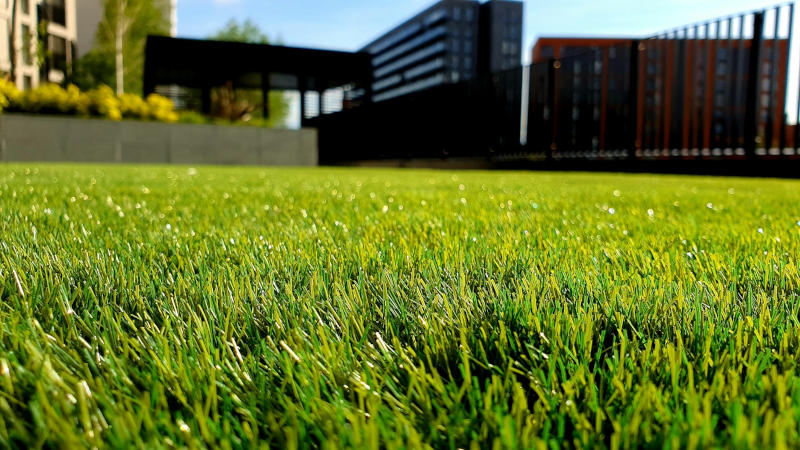If you’re looking to give a new lease of life to an open green space, whether it be a private garden or large community amenity, it might be tempting to opt for artificial grass.
The promise of a perfect green lawn that stays looking good year-round with minimal maintenance sounds like an appealing proposition for time-poor homeowners and organisations. Yet, artificial grass isn’t as picture-perfect as it looks on the surface.
Despite its lush green look, artificial grass is incredibly damaging to the environment, with significant implications throughout its lifecycle - from manufacturing, through use, and at its end of life.
What is Artificial Grass?
Also referred to as ‘synthetic turf’, artificial grass is a man-made product designed to mimic the look and feel of real grass. It’s typically comprised of synthetic fibres, combined with colourants and UV stabilsers to ensure it maintains its green colour over time.
These fibres are attached to a backing layer, usually made from plastics like polyethylene, polypropylene or nylon. Infill materials, like sand and rubber granules, are then added to keep the ‘grass’ upright and create a fuller look and a softer, cushioned surface.

How does artificial grass negatively impact the environment?
The global market is growing at an exponential rate, expected to surpass £4 billion by 2027. But as the demand for synthetic turf rises, so too do the carbon emissions associated with it.
Here, we explore why you should think twice before sacrificing biodiversity and environmental health for convenience and aesthetics.
Carbon intensive manufacturing process
The artificial grass manufacturing process is incredibly energy-intensive. This includes the extraction of raw materials needed to create the plastic, the production process for the individual synthetic components, the composition of the artificial turf product itself, plus any packaging and transportation.
According to GreenMatch, , an artificial lawn of 60 square metres can generate approximately 435kg of CO2 emissions through its manufacturing process. Producing enough artificial grass to cover a football pitch has a carbon footprint equivalent to flying from London to Athens.
Harmful materials
Artificial grass is made up of synthetic materials and chemicals which can release toxins and volatile organic compounds (VOCs) into the environment. This poses risks for wildlife and human health.
A report from Safe Healthy Playing Fields shows synthetic turf contains ‘unsafe levels’ of lead, mercury, cadmium and other known carcinogens. These chemicals can cause damage to skin with prolonged exposure and lead to the inhalation of toxic particles.
On top of these considerations and concerns, artificial grass can also contribute to microplastic pollution as it breaks down into smaller parts over time.
Water and drainage
While you may assume artificial grass is a better choice for water conservation because it doesn’t require regular watering in the summer months like real grass, synthetic turf comes with its own water-related issues. And, unbeknown to many, some products do require regular watering or chemical treatments to help them maintain their visual appeal.
Unlike natural surfaces, artificial grass doesn’t absorb rainwater and allow it to soak into the soil below. With the layers, backing and infill materials, artificial grass has a very compacted base, which prevents water infiltration and restricts air flow, impacting the health and quality of the ground beneath it.
The lack of natural infiltration and drainage means that the rainwater runoff is often contaminated by chemicals from the synthetic materials and colorants. This runs into the surrounding waterways and land, causing pollution and damage to human, animal and plant life.
Wildlife and biodiversity
While natural grass provides food and shelter to a wide range of insects and small animals, artificial alternatives cannot host the same natural organisms and resources, leading to a decline in biodiversity in the area. It can also cause wildlife to ingest its harmful materials and chemicals, further damaging the ecosystem.
Heat absorption
Synthetic grass absorbs and retains heat, becoming up to 20°C than the air temperature on hot summer days and leading to burns and blisters. Some surfaces require watering on hot days to cool them down for use, increasing water consumption. This can also contribute to the urban heat island effect, exacerbating heat stress and climate change.
Durability concerns
While artificial grass is rated highly for its durability and ability to withstand heavy use, it can be compromised by strong weeds that grow and push through the backing material. This can cause holes to form and means that sections have to be replaced, increasing waste and cost.
Disposal and end–of-life
While natural grass grows and decomposes, contributing valuable assets and nutrients to the ecosystem, artificial grass isn’t biodegradable and must be uprooted and disposed of when it reaches end-of-life. As a combination of various synthetic materials and chemicals, artificial grass often ends up in landfill, where it continues to leak toxins into the environment.
While, more positively, recycling options for some types of synthetic turf are on the rise, the process typically requires the different materials to be separated, which can be complex and time-consuming, as well as energy and water-intensive.
Achieving and maintaining beautiful green spaces, without compromising the environment
While artificial grass brings various time and maintenance benefits, on closer inspection, it’s not as picture-perfect as it seems. Not only does it pose risks to human health and damage biodiversity, but its embodied and operational carbon footprints are significant.
Although natural grass requires more regular maintenance, it’s infinitely more beneficial to the environment and a much safer route for sports, playing fields and community amenities. And, with the advent of new developments and innovations, like Foamstream, caring for natural grass is quicker and easier than ever. Our herbicide-free weed control solution means you can achieve lush green lawns without compromising the environment.
Learn more about our safe, effective, eco-friendly weeding solutions here, or get in touch for more information.


